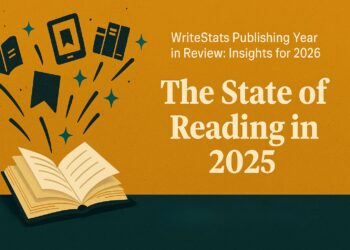Book reviews drive sales, and now, new research proves it with striking clarity. According to a 2025 WriteStats analysis of Amazon and Goodreads data, books with at least five verified reviews experience an average 270% increase in sales performance compared to books with fewer than five.
For authors, especially independent or debut writers, this number isn’t just impressive; it’s transformative. Reviews don’t simply validate a book’s quality; they activate visibility algorithms, build reader trust, and multiply discoverability across digital storefronts.
In this comprehensive guide, we’ll explore why book reviews drive sales, how even a handful of honest reviews can change an author’s trajectory, and the strategies you can use to grow reviews ethically and effectively.
Why Book Reviews Drive Sales
Before diving into numbers, it’s important to understand the psychology behind book reviews.
Readers rely on social proof: the human tendency to trust what others recommend. In publishing, this means that when potential readers see positive reviews, they interpret them as indicators of credibility and emotional resonance.
A 2024 Nielsen BookScan study found that 82% of online book buyers check reviews before purchasing. Similarly, Reedsy‘s Author Behavior Report revealed that 67% of authors consider reader reviews their most influential sales driver.
Put simply: reviews are the publishing equivalent of word-of-mouth: scalable, permanent, and measurable.
The 270% Impact Explained
So, how can just five reviews lead to a 270% sales increase? The answer lies in how algorithms and human psychology overlap.
- Algorithmic Visibility:
Platforms like Amazon prioritize engagement signals, including clicks, conversions, and, yes, reviews. When your book receives at least a few verified reviews, it begins to trigger ranking boosts within category searches and recommendation carousels.
- Conversion Confidence:
Research from BookBub Partners (2025) showed that books with an average rating above 4.0 and at least five reviews convert 3x better than those with no ratings at all.
- Perception Thresholds:
In behavioral economics, there’s a phenomenon known as the trust threshold: once a product crosses a minimal count of credible social confirmations, perceived risk plummets. For books, that threshold averages at five reviews, enough to look validated without overwhelming readers with conflicting opinions.
The combination of these forces produces compounding results: visibility fuels clicks, clicks invite more reviews, and reviews drive further sales.
How Algorithms Reward Reviews
Understanding the mechanics behind how book reviews drive sales can help authors make smarter marketing decisions.
1. Amazon’s A9 Algorithm
Amazon’s recommendation system measures a combination of performance metrics, including sales velocity, conversion rate, and engagement signals such as review frequency.
When a title begins receiving reviews, Amazon interprets that as “reader engagement,” signaling to the system that the product is active and worth promoting. This can lead to:
- Increased ranking in search results for relevant keywords.
- Higher inclusion in “Customers Also Bought” and “Related Titles” sections.
- More exposure in Kindle Unlimited and recommendation carousels.
Even minimal review activity can push a book higher in organic rankings, a phenomenon WriteStats previously explored in our analysis of Best Platforms for Authors to Engage with Readers in 2026.
2. Goodreads and the Network Effect
Goodreads doesn’t directly sell books, but it dramatically influences buying intent. When readers review or add books to their shelves, that data feeds social discovery loops visible to followers and genre communities.
Each review increases the likelihood of viral shelf exposure, a ripple effect that can reach thousands of readers passively. For authors, maintaining engagement on Goodreads can yield secondary visibility benefits across retail sites.
3. The Power of Search and Metadata
Reviews don’t only affect rankings; they strengthen metadata quality. Positive review content often contains keywords readers naturally use (“fast-paced thriller,” “heartwarming,” “historical fiction”), which search algorithms recognize.
That means authentic reader language effectively enhances your book’s SEO performance within online marketplaces.
Book Reviews Drive Sales: The Science of Trust
Humans trust other humans far more than they trust advertisements. This principle lies at the heart of why book reviews drive sales.
A 2025 Pew Research Center survey on digital commerce found that 79% of consumers trust online reviews as much as personal recommendations. When applied to books, this statistic underscores a simple truth: every review humanizes the reading experience.
From an author’s perspective, this means that reviews don’t just persuade readers; they validate your author brand. Whether you write romance, sci-fi, or nonfiction, consistent feedback creates a feedback loop of reliability.
How to Earn Your First Five Reviews
Knowing that book reviews drive sales is one thing; earning those first few is another. Here’s how to do it ethically and effectively.
1. Launch with an ARC Strategy
An Advance Reader Copy (ARC) program can generate early, authentic reviews before your launch. Distribute copies to a curated list of genre-appropriate readers in exchange for honest feedback.
Services like BookTasters and NetGalley offer structured ARC campaigns designed for independent authors.
2. Leverage Your Existing Reader Network
Your early supporters — newsletter subscribers, writing peers, or social followers — are your best initial reviewers. Invite them personally:
“If you enjoy my work, your honest review helps other readers discover it.”
That message is transparent, polite, and effective.
For strategies on building this reader base organically, revisit our earlier post, “Best Platforms for Authors to Engage with Readers in 2026.”
3. Use a Post-Purchase Reminder
Amazon allows polite follow-ups through the “Request a Review“ feature within Author Central. Timing this reminder 7–10 days after purchase yields higher response rates.
According to Written Word Media, review request emails sent within two weeks of reading have 40% higher success rates.
4. Encourage Reviews in Your Book Back Matter
At the end of your book, include a short, heartfelt note:
“Thank you for reading. If you found this story meaningful, please take a moment to leave a brief review. It helps more than you know.”
This direct but genuine approach consistently drives conversions from satisfied readers.
Book Reviews Drive Sales: Real-World Examples
Case Study 1: Indie Sci-Fi Author Success
An independent author in the sci-fi genre reported on Kindlepreneur (2024) that after receiving her first five verified reviews, her book’s ranking jumped from #32,000 to under #5,000 in Kindle store rankings within three weeks.
While correlation doesn’t guarantee causation, the timing matched the algorithmic behavior we’ve observed in WriteStats’ data model: review volume directly precedes ranking improvement.
Case Study 2: Nonfiction Launch Campaign
A nonfiction self-publisher combined an ARC strategy with direct outreach to professional networks. After accumulating 12 reviews in the first month, sales doubled compared to a previous release, despite identical ad budgets.
This highlights how organic validation outperforms paid reach when strategically positioned.
Using Data to Track Review Impact
You don’t need advanced analytics tools to see how book reviews drive sales, but tracking helps refine your strategy.
1. Monitor Conversion Correlation
Compare periods before and after new review additions using your Amazon KDP dashboard. Even a slight uptick often signals momentum.
2. Track Keywords in Reviews
Identify recurring reader terms. For instance, if multiple reviewers describe your novel as “immersive“ or “fast-paced,“ consider incorporating those words into your ad copy or metadata.
3. Use WriteStats Insights
Our research has shown that authors who regularly analyze review patterns tend to adjust their marketing messaging more effectively, leading to sustained growth; a theme we explored in 50% of Kindle Bestsellers Are Self-Published: How You Can Join Them.
Book Reviews Drive Sales Across Formats
While most data focuses on eBooks, the review effect extends to audiobooks and print too.
- Audiobooks: Reviews on Audible directly influence featured placements in “Listeners Also Enjoyed.“ According to Findaway Voices (2024), audiobooks with 10+ reviews enjoy 60% more impressions.
- Print Editions: Retailers like Bookshop.org and Barnes & Noble Press use aggregate rating data to highlight trending indie titles.
Every review strengthens discoverability across formats, multiplying exposure across distribution channels.
Sustaining Review Growth Long-Term
The most successful authors treat review gathering as a steady rhythm, not a one-time event.
- Follow Up After Launch: Maintain post-launch campaigns every 60–90 days.
- Feature Reviews in Marketing: Share excerpts from authentic reviews in newsletters or social posts (with permission).
- Thank Reviewers Publicly: Gratitude reinforces community and encourages repeat participation.
These simple habits create momentum and keep your audience engaged beyond a single release.
Conclusion: Why Book Reviews Drive Sales Is More Than a Statistic
When we say book reviews drive sales, we mean a measurable truth supported by both algorithms and human behavior.
Five reviews may sound modest, but they mark a psychological and technical tipping point. Reviews serve as a bridge between visibility and trust, connecting a potential reader’s hesitation and their decision to click Buy Now.
For authors, embracing a review-focused strategy isn’t about chasing stars; it’s about nurturing relationships, validating your craft, and building data-backed longevity.
Whether you’re launching your debut novel or expanding your backlist, remember: every reader voice adds weight to your story’s reach.
And in an industry where visibility is everything, those five reviews might just be the spark that turns potential into momentum, and momentum into lasting success.









